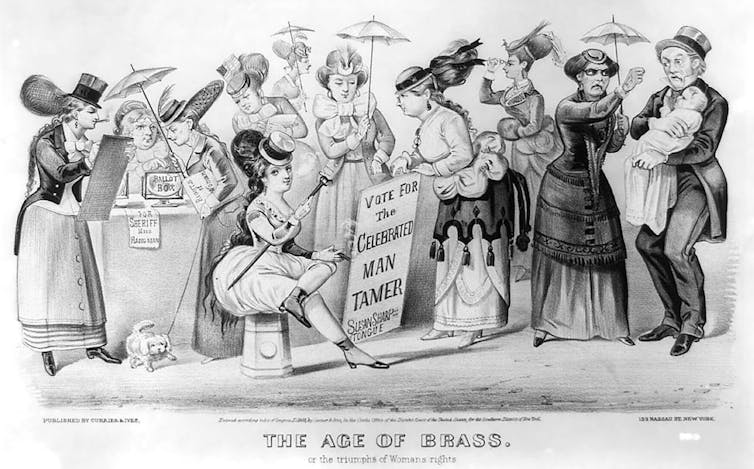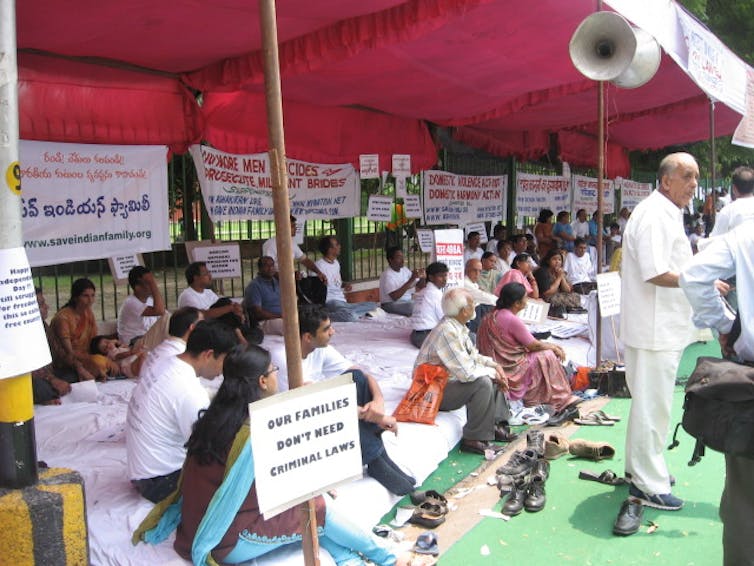Toronto, April 23, 2018: A man drives a van into a group of pedestrians, killing eight women and two men and injuring several others.
While the investigation is still ongoing and the suspect’s trial is months away, a message published by the accused on social media already provides insight into possible motivations, associating him with the movement of “involuntary celibates” or “incels.”
Incels are chiefly active on social media and claim that men suffer from a lack of female sexual availability, leading both to suicide among men and violence against women, including mass murders. The movement has its own heroes and martyrs, such as Elliot Rodger (described as a “supreme gentleman” by the Toronto suspect), who killed six people in California in 2014, explaining in a video that he wanted to punish women because he had never had sexual relations.
Read more: The dark possible motive of the Toronto van attacker
Although this is an extreme example of the “crisis of masculinity” rhetoric — the idea that men are suffering at the hands of women in general and feminists in particular — it’s not the only mass murder associated with this kind of discourse.
The ghost of Montreal
On Dec. 6, 1989, a man killed 14 women at the Montreal Polytechnique, claiming that “feminists” had “ruined his life.”

The attack was presented by several contemporary commentators as proof that the men of Quebec were suffering an identity crisis. More recently in Norway, neo-Nazi Anders Breivik killed dozens of young members of the Socialist Party, explaining in his manifesto that feminists are threatening the virility of Western civilization. In the months following the attack, female journalists were the target of sexist insults and death threats from members of the so-called “Breivik Fan Club”.
Crisis or crisis rhetoric?
Historian Judith A. Allen and others, including Mary Louise Roberts, have warned that the notion of a “crisis of masculinity” clouds our understanding of complex social phenomena.
They argue that the concept of “crisis,” which implies serious upheavals and profound transformations, does not accurately describe the reality of relations between sexes and the condition of men in society.
Allen underlines the importance of monitoring real-life institutions and social relations to ascertain whether it’s men or women who are at the top of the major political, economic and cultural institutions, which group has the most resources (property, money, firearms, etc.), who is afraid of whom, who carries out the unpaid work of looking after others (husbands, children, the sick) and so on.
This approach quickly reveals that one should more accurately speak of a “rhetoric of crisis,” as Allen suggests, rather than an actual crisis.
Others have made the same observation, including Jie Yang, who studied masculinity crisis rhetoric in post-Maoist China. Yang deplores the fact that the majority of studies on the so-called crisis of masculinity are based on material from newspapers, novels, films and interviews:
“This approach can create the illusion that literary texts adequately reflect what is truly happening in society.”
Even if there is no real crisis, Yang and others have demonstrated that the rhetoric of crisis can have a real impact on society. It brings the attention of authorities and public opinion to those supposedly in crisis (in this case, men), allowing them to present themselves as victims and therefore in need of help (resources, services, etc.).
It also enables the root causes of the alleged crisis to be identified and delegitimized (in this case, feminists and women). It can even be used to justify mass murder and glorify the memory of murderers, presented as heroes, rebels or members of the resistance.
An overly long tradition
We should be all the more wary of the notion of a “crisis of masculinity” since Western history is littered with examples of this rhetoric, from as early as ancient Rome to the end of the Middle Ages and throughout each successive century across the Western world, including such powerful countries as Germany, the United States, and France.
The 20th century seems to be dogged by a continuous crisis of masculinity, including in the Eastern Bloc, both during the Cold War and after liberalization.

In these countries, the rhetoric of a crisis of masculinity was propagated by the highest authorities, including kings and presidents, religious elites, academics, famous writers, prominent members of patriotic leagues and representatives from chambers of commerce.
It was used as a means to criticize mothers and wives depicted as dominating, and to chastise women who did not conform to strictly laid-out female roles (in the way they dressed or did their hair, carried firearms or practised traditionally masculine professions). The rhetoric of crisis also helped justify punishment of women and brought about new resources for men, including the development of amateur sport, gentlemen’s clubs and so on.

‘Global feminist terrorism’
Today, studies around the globe speak of a crisis of masculinity in countries as diverse as India, Israel, Japan and Russia, as well as among Christian, Jewish and Muslim men.
In the West, some claim that African-American men and “young Arab” men are violent because they are suffering from a crisis of masculinity or, conversely, that they are more virile than the white man, who is “castrated” and defenceless against the Black man or Muslim immigration.
Demonstrably, the notion of a crisis of masculinity can be used to substantiate a plethora of contradictory claims.
The rhetoric can be reoriented, depending on the context: Prior to easier access to divorce, the dominating wife was responsible for the crisis; nowadays, it’s the ex-wife. In some countries today, the discourse touches on higher rates of suicide among men, boys’ difficulties in school, the obligation to pay alimony post-divorce and even laws against domestic violence, which have been presented by groups of men in India as the result of “global feminist terrorism.”

Today, the rhetoric of crisis is still largely disseminated by wealthy middle-class men with higher-than-average levels of education and good jobs (according to studies in the United States, India, Sweden, and elsewhere).
They are intellectuals, psychologists and social workers, but also activists from groups of separated or divorced fathers, Christian organizations who run men-only retreats, and white supremacists in the neo-fascist networks.
Conventional masculine identity: A risk factor
The rhetoric of the crisis of masculinity offers an opportunity to reaffirm a radical division of humanity into men and women, to associate masculinity with certain stereotyped qualities (action, competitiveness, aggressiveness and violence) and claim that femininity is at once different, inferior and dangerous to men, since the feminine influence is cast as pathological and liable to lead to the decline or even the disappearance of men.
Yet if we look closely at studies of the symptoms supposedly arising from a crisis of masculinity — suicides, difficulty in school, divorce, etc. — we see that women are very often not the cause and, above all, that conventional masculine identity constitutes a risk factor rather than a solution.
In the case of suicides, for example, the high rates for men can be explained, among other things, by the idea that virility and firearms go hand-in-hand, and by the overlap between masculine and professional identity, leaving men more vulnerable in the case of unemployment. Epidemiologists also note that suicide rates rise in times of economic crisis, a phenomenon that cannot be attributed to women, since they do not run the economy.
Even more troubling, the notion of a crisis in masculinity implies that equality is a feminine value that threatens male identity. In this framework, masculine identity is above all a political identity, associated with privileges (in the bedroom, the boardroom, etc.) that are supposedly due to men, while important everyday tasks, like cooking food and looking after children, are seen as incompatible with healthy masculinity.
This discourse is right out of the male supremacist playbook, drawing on the same ideas that might have motivated attacks like that in Toronto.
The author recently published La Crise de la masculinité: autopsie d’un mythe tenace (“The Crisis of Masculinity: Autopsy of a Persistent Myth”), Montréal, Remue-ménage Publishing.
Translated from the French by Alice Heathwood for Fast for Word.


